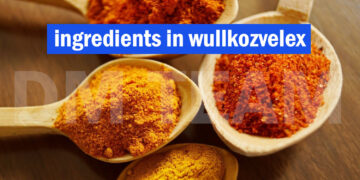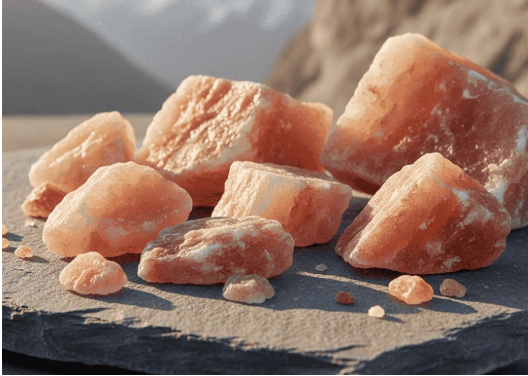Salt is one of the most essential minerals on Earth, used daily in homes, restaurants, and industries around the world. But not all salt is created equal. Among the most celebrated varieties is Himalayan salt, admired for its distinctive pink hue and rich mineral composition.
Ever wondered how this ancient salt travels from deep mountain deposits to your dining table? Let’s take a closer look at the fascinating journey of Himalayan salt from its geological formation to its final form in your kitchen.
1. The Origins: Formed by Nature Millions of Years Ago
Himalayan salt comes from the Khewra Salt Mine, located in the foothills of the Salt Range in Pakistan. Scientists believe this region was once part of a vast, ancient seabed that evaporated over 250 million years ago.
As the sea dried up, thick layers of crystallized salt remained, later buried under the Earth’s crust by shifting tectonic plates. Over time, pressure and temperature changes transformed these deposits into the beautiful, mineral-rich pink salt we see today.
These natural processes created salt that’s not only pure but also rich in over 80 trace minerals, giving it both its color and unique nutritional profile.
2. Mining the Himalayan Treasure
Extracting Himalayan salt is a careful, manual process designed to preserve its natural purity. The Khewra Salt Mine, one of the largest in the world, produces thousands of tons each year through traditional mining techniques.
Workers use hand tools and controlled methods to cut salt into large blocks, avoiding chemical or industrial processing. The mine itself is an underground wonder filled with tunnels, chambers, and shimmering salt formations that reflect soft shades of pink and orange.
The salt extracted from these mines is later shaped into various products like Himalayan Salt Slabs, lamps, and fine culinary crystals. These slabs, in particular, are valued for their ability to conduct heat evenly and add a mild, natural flavor to foods making them a favorite among chefs and home cooks worldwide.
This human effort combined with natural beauty makes every crystal of Himalayan salt a piece of geological history.
3. The Journey of Transformation: From Rock to Kitchen
Once mined, the raw salt blocks are transported to processing facilities where they are cleaned and refined without losing their natural essence. The salt is then cut, carved, or ground depending on its final purpose culinary, decorative, or therapeutic.
From slabs to grinders, Himalayan salt continues to find new ways into our kitchens offering both beauty and function in every grain.
4. Quality and Authenticity: What Makes Real Himalayan Salt Unique
Not all pink salts are truly Himalayan. Authenticity depends on the source, mineral composition, and processing methods. Genuine Himalayan salt can be identified by its origin (Khewra mines) and its characteristic warm tones ranging from light pink to deep red.
This authenticity matters not only for taste but also for quality assurance. Pure Himalayan salt contains essential trace elements like magnesium, calcium, and iron minerals that add both flavor and natural color.
5. Global Distribution: Connecting Nature and Homes Worldwide
From the mountains of Pakistan, Himalayan salt travels across continents to reach homes, restaurants, and wellness centers. The export process involves careful packaging, quality checks, and logistics to maintain purity from mine to market.
Reliable suppliers such as Sobaan Salts Exporter ensure that Himalayan salt retains its natural texture and mineral integrity throughout its journey. Their commitment to sustainable mining and ethical production supports local communities while preserving the authenticity of this ancient resource.
As global demand for natural products rises, such responsible exporters play a crucial role in bridging the gap between tradition and modern living.
6. Beyond Cooking: Himalayan Salt in Wellness and Design
While its culinary uses are widely known, Himalayan salt’s applications go far beyond the kitchen. It’s used in salt lamps, spa treatments, and even architectural décor. The gentle glow and mineral composition are believed to promote relaxation and air purification making it a favorite in wellness and interior design spaces.
From detoxifying salt baths to therapeutic salt rooms, this mineral’s versatility proves that nature’s creations often serve more than one purpose.
7. The Final Destination: A Natural Gift for Modern Living
By the time Himalayan salt reaches your table, it has traveled through millions of years of history, thousands of hands, and countless careful processes. Each grain carries a story from ancient oceans to modern homes symbolizing purity, patience, and connection with the Earth.
It’s a reminder that even something as common as salt has an extraordinary journey and when it comes from the heart of the Himalayas, that journey is nothing short of fascinating.
Conclusion: Nature’s Legacy Preserved in Every Crystal
Himalayan salt’s path from mountain to kitchen isn’t just about extraction and trade, it’s about preserving a natural legacy. The combination of geological wonder, traditional craftsmanship, and sustainable practices makes this mineral one of the most remarkable on Earth.
So next time you sprinkle pink salt over your meal or cook on a glimmering salt slab, remember: you’re tasting a piece of ancient history, shaped by time, nature, and human care.









































